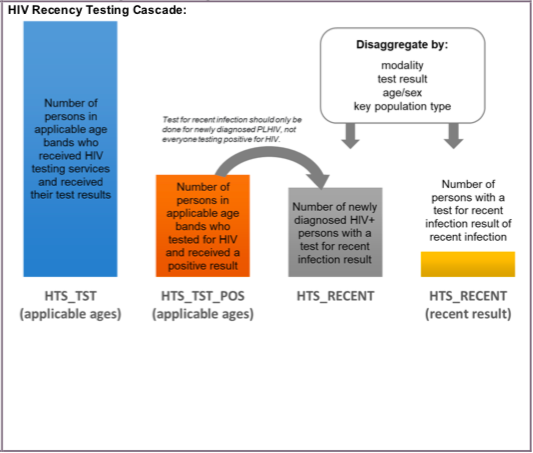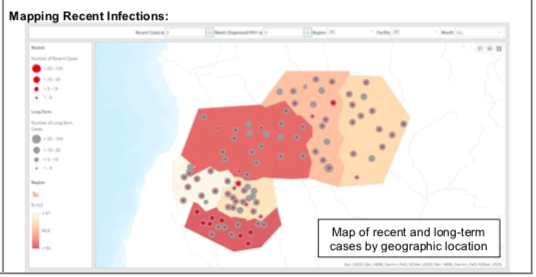(HTS_RECENT) Number of newly diagnosed HIV-positive persons who received testing for recent infection with a documented result during the reporting period
Export Indicator
As countries progress toward epidemic control, surveillance of newly diagnosed persons will ensure that interventions target those at highest risk of acquiring or transmitting HIV infection. One approach is to identify recent HIV infections, defined as those acquired within approximately the last one year. Incorporation of rapid tests for recent HIV-1 infection into routine HIV testing services will enable the establishment of a surveillance system to quickly detect, monitor, characterize, and intervene on recent infections among newly diagnosed HIV cases. Data collected from a recent infection surveillance system can also be used to fine-tune a country’s programmatic response through prioritized programming and resource allocation.
Recommended use of this indicator is described below. For additional information on recent infection surveillance, please refer to the PEPFAR guidance on recent infection testing, template protocol on establishing recent infection surveillance, TRACE (Tracking with Recency Assays to Control the Epidemic) toolkit and eLearning Hub, and the emerging technology page on pepfarsolutions.org.
- Surveillance: Characterization of recent and long-term HIV infections will enable the identification of geographic areas and/or demographic groups that may benefit from intensified prevention and testing activities and may also be used to monitor epidemic trends over time.
- Public Health Program Response: Monitoring the number and percentage of recent infections by facility and community can be used to identify areas with ongoing active transmission to quickly target education, prevention, and testing resources to increase case finding, intensify index testing services, and subsequently interrupt disease transmission. Disaggregation by age, sex, modality, and key population type can further identify subpopulations at higher risk to inform program planning and implementation. Changes over time should be monitored to assess program impact.
- Program Implementation: The indicator may be used to monitor the rollout of testing for recent infection. A crude estimate of testing coverage may be calculated using: HTS_RECENT by applicable age/sex bands divided by HTS_TST_POS by applicable age/sex bands. Tests for recent infection should be performed as a supplementary test for persons who are diagnosed with HIV-1 through the national HIV testing algorithm. The results of tests for recent infection should be used for surveillance purposes and are not intended to affect clinical management. Results may or may not be returned to patients depending on country context and policies. If results are returned to patients, counseling messages should be provided to explain the results and emphasize that HIV care and treatment will not differ based on recent infection status.
Please see the diagrams below that describe the HTS_RECENT flow in more detail. Two examples are shown for testing done at the facility/community and testing that involves sending specimens to a laboratory to confirm RTRI recent results.

Number of newly diagnosed HIV-positive persons who received a test for recent infection with a documented result during the reporting period
N/A
How to calculate annual total: Sum results across quarters
How to collect:
Data for this indicator are reported at both the facility and community levels. HTS_RECENT should be reported alongside HTS_TST at facilities and communities where tests for recent infection have been incorporated as a supplemental test to the country-approved HIV diagnostic testing algorithm.
Even if the testing algorithm requires facility or community-based providers to refer specimens to a laboratory or hub facility for testing for recent infection, the indicator should be reported under the facility or community testing partner where the specimen was collected. This means that HTS_RECENT should be reported by the clinical service partner (or equivalent) supporting the facility or community where the test for recent infection was performed. However, in limited cases, reporting may need to be done by other partners supporting recent infection surveillance, such as surveillance or laboratory partners. For example, if a facility sends specimens of persons who test recent to a laboratory to perform viral load testing to confirm recent status, then it may make sense for the laboratory to report confirmed results.
Electronic case-based surveillance systems that incorporate test for recent infection results may be used to collect and report data for this indicator. Where those systems do not exist or do not include test for recent infection results, existing HTS registers, log books, and reporting forms that have been modified to incorporate test for recent infection results may be used. Tools specifically designed for test for recent infection would be another option to collect and report data.
Country guidelines may vary in reference to the time point and setting at which testing for recent infection is conducted. HTS is recommended, but other service delivery points may be considered if the test for recent infection is conducted within a short period of initial HIV diagnosis. Ideally, the test for recent infection should be conducted at the same time as diagnosis. Data for this indicator are collected and reported regardless of whether or not test results have been returned to the patient.
If guidelines specify that viral load testing be conducted alongside the test for recent infection as part of a recent infection testing algorithm (RITA), then these results should be recorded in addition to the rapid test for recent infection (RTRI) results. Because RITA results will take longer than RTRI, do not wait for RITA results to report the RTRI results. Viral load testing should be incorporated at facilities/communities with ready access to viral load testing or sample referral networks but is not required at facilities/communities that do not have this infrastructure in place.
Key populations:
Information on tests for recent infection should be reported by key population (PWID, MSM, TG, FSW, and people in prison or other closed settings) where it is safe to collect this information.
See Appendix A: Key Population Classification Document, to inform identification of key populations at HTS service delivery. Reporting of key population disaggregation should be consistent with what is described under the KP_PREV “How to review for data quality” section on mutual exclusivity of an individual who falls under multiple key population categories (e.g., FSW who injects drugs). In such instances, the individual should only be reported in ONE key population disaggregation category to avoid double-counting.
Note: Both key population-specific and clinical partners should complete these disaggregations, but only if it is safe to maintain these files and report. Age and sex data on key populations receiving tests for recent infection will not be reported. Please refer to the KP_PREV indicator reference sheets for more information on working with key populations. The first priority of data collection and reporting of HTS_RECENT among key populations must be to do no harm. These data must be managed confidentially to ensure the identities of individuals are protected and to prevent further stigma and discrimination.
How to review for data quality:
- HTS_TST_POS (≥15 years) ≥ HTS_RECENT: The number of persons age ≥15 years who received HIV testing services and received a positive result should be greater than or equal to the number of persons who tested for recent infection.
- HTS_RECENT (RTRI) > HTS_RECENT (confirmatory testing): The number of persons with a RTRI result should be greater than the number of persons with a confirmatory testing result. Confirmed results, if viral load testing is being done, should be reported as a subset of RTRI results.
- HTS_RECENT ≥ subtotal of pregnancy or key population disaggregates: The number of persons who tested for recent infection should be greater than or equal to the sum of the pregnancy or key population disaggregation group.
Reporting level: Facility & Community
Reporting frequency: Quarterly
![]()
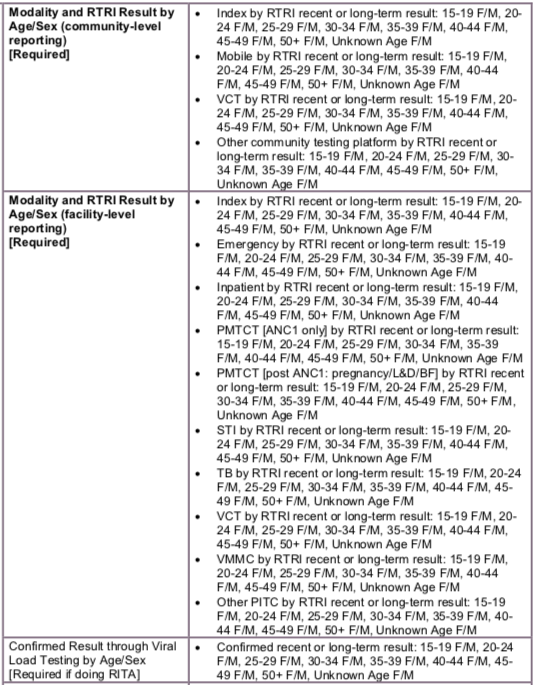

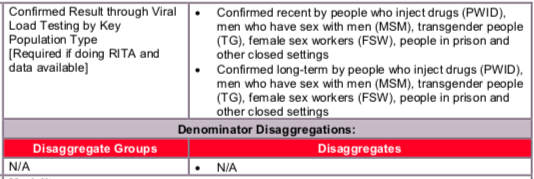
Disaggregate descriptions & definitions:
Modality
- Service delivery modalities can reflect a reason for testing (index, STI), as well as, the location/place of testing (e.g., inpatient ward, VCT drop-in center). This should match the modalities used for HTS_TST reporting. Please refer to the HTS_TST indicator reference sheet for descriptions of the modalities.
RTRI result
- RTRI refers to the rapid test for recent infection. All results from the RTRI should be reported regardless of viral load testing to confirm RTRI recent results.
- A recent result on the RTRI means that the person was likely infected within the last one year. The recent result may be confirmed with viral load.
- A long-term result on the RTRI means that the person was like infected more than one year ago. This is the final result and does not require additional testing.
- The RTRI may produce two other results: invalid and HIV negative. These results should not be reported for this indicator but should be captured in the country’s recent infection surveillance database for monitoring purposes. In the event of an invalid or HIV-negative result, please follow the country’s established procedures for dealing with these results (e.g., retesting, reporting, quality control, etc.).
Confirmed result through viral load testing
- Viral load testing is done to confirm RTRI recent results as part of a recent infection testing algorithm (RITA). Persons who receive viral load testing should be reported as a subset of those reported under RTRI.
- A confirmed recent result refers to RTRI recent cases that have been confirmed by viral load testing to be truly recent.
A confirmed long-term result refers to RTRI recent cases that have been found to be long-term based on viral load testing (false recent cases).
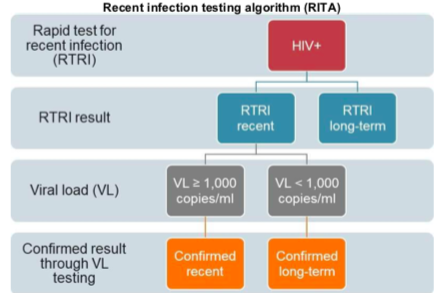
HTS_RECENT should be reported alongside HTS_TST at facilities/communities where tests for recent infection have been incorporated as a supplemental test in addition to the country- approved HIV diagnostic testing algorithm
N/A
Indicator changes (MER 2.0 v2.3 to v2.4):
- Previous numerator and denominator were combined into a single numerator.
- Modality and test result disaggregations were added to align with HTS_TST.
- Pregnancy status disaggregation was removed due to the addition of modality.
- Previous test indication disaggregation (assay, RITA, and not documented) was redefined to align better with reported results and testing algorithms. All assay results will be reported under rapid test for recent infection (RTRI) and confirmed results through viral load testing as part of the RITA will be reported as a subset, where available.
PEPFAR-support definition:
Standard definitions of DSD and TA-SDI apply.
For HTS services, direct service delivery includes: ongoing procurement of critical HTS related commodities such as rapid HIV test kits or requisite materials (lancets, capillary tubes), samples and materials for proficiency testing, other HIV diagnostic commodities, or funding for salaries of HIV testing service providers including counselors, laboratory technicians, program managers, and/or community health workers. Staff who are responsible for the completeness and quality of routine patient records (paper or electronic) can be counted here; however, staff who exclusively fulfill MOH and donor reporting requirements cannot be counted.
For HTS services, ongoing support for service delivery improvement includes: clinical mentoring/supportive supervision, HTS training, HTS guidance development, routine support of HTS M&E and reporting, or HIV test kits consumption forecasting and supply management.
Guiding narrative questions:
- As testing for recent infection is being scaled, please describe the stage/scope of implementation (SNUs, sites, populations, etc.).
- If viral load testing is being done to confirm recent status, please explain if the total number of people who received confirmatory testing does not equal the number reported under RTRI recent. Note that due to turnaround time, viral load results may be delayed, and RTRI results should be reported regardless of whether viral load results are available.
- If HTS_RECENT does not equal HTS_TST_POS (>15 years) for the sites/populations doing testing for recent infection, please explain why. Note that newly diagnosed PLHIV infected with HIV-2 who are not co-infected with HIV-1 should not be tested for recent infection.
- Calculate the percent recent by dividing the number of persons with a recent result by the total number of persons tested. Please explain whether the percent recent is expect, and if not, what investigations are being done.
Data Visualization & Use Examples:
